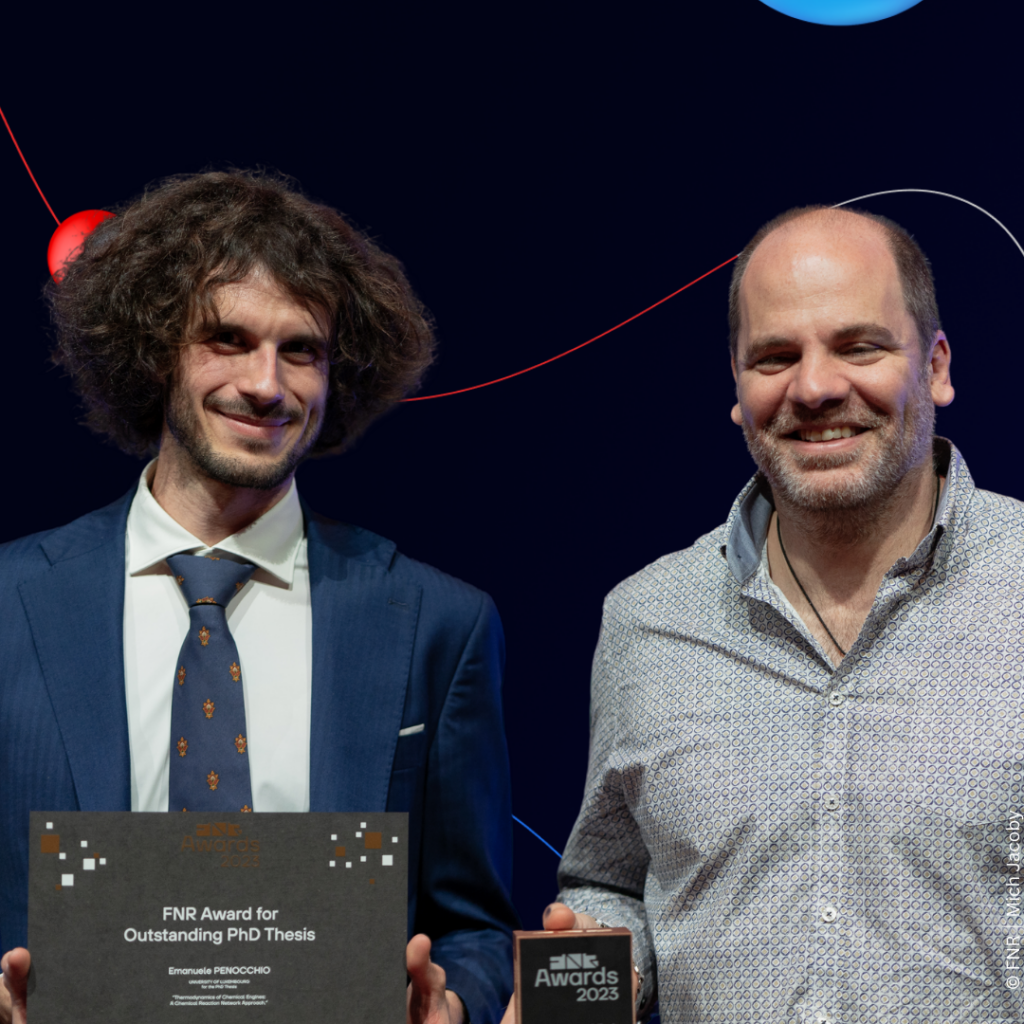10 selected Research Luxembourg results – November 2023
11 December 2023

Luxembourg News in Science & Research
A correlation between pollution and obesity; quantum mechanics and pharmacology; a new refrigeration system; an early detection of Parkinson’s disease: here are the latest scientific news from Luxembourg.
Iván Herrador; Diane Bertel (NightCafé, Craiyon)
This article was originally in French and German on science.lu
Does pollution promote obesity?
Luxembourg Institute of Health (LIH)
A major research effort led by the LIH analyzes the correlation between pollution and cardiovascular diseases (CVD). The study finds associations between obesity, diabetes, hypertension, and dyslipidemia (the main risk factors for CVD) and several chemical compounds frequently found in the environment, such as PCBs (polychlorobiphenyls) and PCP (pentachlorophenol). These substances were once widely used (paint, industry, insulation, etc.) but have been heavily regulated or even banned in recent years in most European countries; they still persist in the environment.
The researchers also highlighted associations between the risk factors for CVD and chronic exposure to currently used pesticides, such as organophosphorus pesticides used since the 1970s (glyphosate is one of them). To obtain their results, they analyzed hair samples from the general adult populations of Belgium and Luxembourg to study chronic internal exposure to three polychlorobiphenyls (PCBs), seven organochlorine pesticides, and 18 non-persistent pesticides.
This research is essential to demonstrate the health impact of certain commonly used chemical products.
To the press release / To the publication
“Regenerator,” a technology that enables cooling without excessive pollution.
Luxembourg Institute of Science and Technology (LIST)
Approximately one-fifth of the world’s electrical energy is dedicated to refrigeration, and existing systems are a significant source of greenhouse gases. In this context, the new refrigeration system designed by LIST, called “Regenerator,” is extremely interesting.
While conventional systems rely on vapor compression, a method with a thermodynamic limit, the LIST researchers’ technology uses a phenomenon called electrocaloric effect: a process in which a material (specifically, a ceramic capacitor) is subjected to an electric field, causing a change in temperature.
In their latest publication, the scientific team responsible for the project presented promising developments, particularly regarding energy efficiency: Regenerator would be more efficient and durable than conventional methods.
To the press release / To the publication
Toward Greater Efficiency in Wastewater Treatment Plants
Luxembourg Centre for Systems Biomedicine (LCSB) ; Faculty of Science, Technology and Medicine (FSTM), University of Luxembourg
A team from the LCSB, FSTM, and their international collaborators have developed a new mathematical and statistical modeling approach that predicts the dynamics of microbial communities (microbiomes) in wastewater treatment plants several years in advance. This microbiome dynamics, which drives the performance process, needs to be predicted and controlled to maximize the efficiency of wastewater treatment plants.
This approach can be used to anticipate problems (such as the emergence of “bad” bacteria) and thus enable the early implementation of countermeasures. It could also provide a better understanding of the human microbiome and other biotechnological processes using the same modeling techniques.
The researchers collected vast amounts of data weekly in a Luxembourg wastewater treatment plant for a year and a half, then reduced them to only 17 fundamental features that determine the composition, abundance, and activity of the microbial community.
To the press release / To the publication
An early detection of Parkinson’s disease soon in sight
Luxembourg Institute of Health (LIH) ; Luxembourg Centre for Systems Biomedicine (LCSB)
Being able to detect Parkinson’s disease early would constitute a major breakthrough in the field of neurodegenerative diseases. A team of researchers from the LIH and LCSB has now published a promising approach: having discovered that the early stage of the disease shows higher activity of the peripheral immune system (specifically, certain T lymphocytes, CD8 TEMRA), especially in women, it might be possible to use cellular immune biomarkers to facilitate diagnosis.
The researchers establish, for the first time, a clear link between disruptions in the peripheral immune system and Parkinson’s disease. Their work details the dysregulation of peripheral immunity, outlining a category of candidates eligible for early diagnosis and treatment. The implications are significant, especially for patients whose disease has no defined genetic cause.
These results were made possible thanks to samples collected by the National Centre of Excellence in Research (NCER-PD).
To the press release / To the publication
Is there a labor shortage in Luxembourg?
Luxembourg Institute of Socio-Economic Research (LISER)
The labor shortage affects Luxembourg as well as most other European countries. In a recent study, LISER highlights it, particularly for jobs that do not require a university degree. The affected sectors include industry, craftsmanship, assembly, as well as machine and equipment operation.
In Luxembourg, in 2022, 76% of companies with at least five employees reported difficulties in recruiting staff, with the main reason being a lack of candidates. Issues related to working conditions are emphasized: payment for overtime and shift work represents only 6.3% of the remuneration in shortage occupations, compared to 10.3% in other occupations; average salary and the weight of bonuses and allowances are also lower for certain jobs in shortage.
The consequences of such an imbalance are detrimental to the economy as they hinder investments and the development of businesses.
To the press release (in French)

Iván Herrador; Diane Bertel (NightCafé, Craiyon)
What do we know about cross-border mobility in Luxembourg?
Faculty of Humanities, Education and Social Sciences (FHSE), University of Luxembourg ; Luxembourg Institute of Socio-Economic Research (LISER)
A book exploring cross-border workers in Europe and the Greater Region has just been published. It is the result of collaboration between the University of Luxembourg, the University of Lorraine, and LISER. The book analyzes the social, economic, cultural, territorial, and legal dimensions of cross-border employment, which has been on the rise for years.
The topics covered range from wage disparities, access to the labor market including the question of identity, daily life, language, and more. This labor mobility is an important economic research question in Luxembourg: it can be a source of growth and purchasing power but nonetheless results from socio-economic imbalances in border regions.
What will the decarbonization of the Grand Duchy look like?
Luxembourg is gradually approaching carbon neutrality by 2050, although not fully achieving it in the current projections. This observation comes from the latest simulation by STATEC regarding past and future measures taken by the Grand Duchy to reduce its greenhouse gas emissions and overall energy consumption.
The way this decarbonization should occur differs from sector to sector: for the transportation sector, electrifying the vehicle fleet and successive increases in the CO2 tax would bring about the fastest reduction in emissions. In the building sector, it would be energy efficiency standards for new constructions and the non-replacement of fossil boilers at the end of their life. And in the industry, the main long-term determinant would be access to green hydrogen.
According to projections, this energy transition would have only a limited impact on activity from a macroeconomic perspective.
To the press release (in French) / To the publication (in French)
The raccoon roundworm: a potential problem in Europe?
Luxembourg National Museum of Natural History (MNHN)
It took 181 intestines to determine the dangerous spread of the raccoon roundworm. A team of researchers, including four from the MNHN, conducted genetic analyses on a large number of samples collected in Saxony-Anhalt.
The raccoon roundworm (Baylisascaris procyonis), a gastrointestinal nematode, can cause death or permanent neurological damage in humans. This parasite was accidentally introduced to Europe with its host, the North American raccoon. Infected raccoons transmitted it to a previously uninfected German raccoon population. The researchers advocate for continuous monitoring of populations by health authorities and public awareness of the infectious risk: prompt detection and treatment can prevent severe consequences in humans, who become infected by ingesting eggs present in the soil (typically the case for children). The eggs can survive in the environment for years.
The authors believe it is not possible to control the spread of the parasite due to its high prevalence, the high densities of raccoons, and the potential for transmission to other animals.
To the press release / To the publication
Quantum chemistry comes to the aid of pharmacology
Department of Physics and Materials Science (DPhyMS), University of Luxembourg
Physicists from the University of Luxembourg and experts from Avant-garde Materials Simulation (AMS) have used computer simulation to predict the stability of crystalline forms of certain substances, also known as polymorphism (the ability to exist in multiple forms while maintaining the same chemical composition). Their innovative method is affordable, reliable, and reproducible, which could lead to significant advances in the field of pharmacology.
Specifically, the researchers modeled and predicted the free energy of crystals under real conditions of temperature and humidity without relying on empirical data. The stability of a crystalline form is related to its free energy: the lower the free energy, the greater the stability. The researchers used high-performance computing (HPC), predicting and explaining data from seven pharmaceutical companies with surprising accuracy.
These results, published in Nature, once again demonstrate the great potential of quantum chemistry.
To the press release / To the publication
Our hair, indicators of pollutants
Luxembourg Institute of Health (LIH) ; Anses ; Ineris – Institut national de l’environnement industriel et des risques
Rat hairs are a good indicator of the pollutants to which animals have been exposed. And by extension, so are our hairs.
In a study specifically designed by the LIH, Anses, and the National Institute of Industrial Environment and Risks, scientists looked into the best method for detecting chemical pollutants such as bisphenols, phthalates, or certain pesticides. The problem with these substances is that their elimination in the blood or urine is sometimes too rapid to be effectively detected; this is not the case when they bind to the keratin in hair. Scientists found a good correlation between the exposure dose by ingestion and the concentration of metabolites measured in rat hairs.
This work is important for improving the analysis of the effects of these chemical substances on our bodies. Many studies use blood and urine samples to determine correlations, but this could skew certain results.
Author: Diane Bertel
Editor: Lucie Zeches (FNR) ; Hélène Jacuszin (Research Luxembourg)








